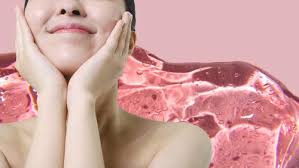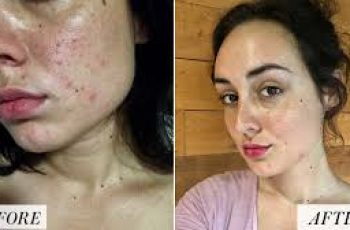
Jello Skin Beauty Trend
The Tik Tok trend started by beauty influencer Ava Lee has everyone is talking about Jello Skin. What does jello skin mean and how do you get it?
It all started when Ava said her skin bounced back like jello after getting a facial. Everyone went nuts and now the term has entered our beauty vernacular.
It is amazing how quickly these skin care beauty trends catch on with social media and how they have such a strong influence.
Have you ever noticed that once something has drawn your attention, you see it everywhere? That happened for me with the Jello skin concept. I just read the book Dune and the Fremen on the desert planet Dune value water more than anything else. They refer to others that have “water plump skin” which is a desirable trait in the book When I came to that part in Frank Herbert’s book, meaning you can afford to buy water on the desert planet. I immediately thought “They mean jello skin!” -LOL- which shows that Tik Tok beauty trends can even influence a dermatologist’s vocabulary.
But what does it mean to have water plump skin or jello skin?
What is the definition of jello skin?
What is the Definition of Jello Skin?
Obviously “Jell-O skin” is a metaphor more than a scientific term meant to give imagery of “plump hydrated skin” bursting with a surplus of water.
To understand jello skin, you need to know a bit about how your skin holds onto water.
I have seen others say that jello skin indicates a large amount of collagen in the skin, however that is not correct. Collagen does give skin strength, but it is water in the skin that gives skin the plump jello feel. Skin care ingredients that boost collagen production won’t give you jello skin. Keep reading to learn what will!
hyaluronic acid
How skin holds onto water
For skin to have the plump, taught hydrated feel, it must hold onto water. You skin can do this several ways:
Water is held inside the skin cells with Natural Moisturizing Factor
Water is held between skin cells with glycosaminoglycans like hyaluronic acid and heparan sulfate
Water moves between cells through Aquaporin channels
All three of these need to work well or you can end up with a dry skin type.
Glycosaminoglycans
Glycosaminoglycans (also called GAGs) are sugars in the skin that bind water. Just like a sponge soaks up water, GAGs do the same for our skin, making it look fresh and feel soft. GAGs play a very important role in making skin plump, cell communication, and helping stimulate skin cells to make collagen. (Loss of collagen is a cause of aging skin).
When GAGS bind a lot of water, the skin feels plumper, has more volume and is smooth.
Natural Moisturizing Factor
The Natural Moisturizing Factor (NMF) is a group of water-binding compounds found in the inside of skin cells on the top layer of the skin. Its main job is to help the skin stay hydrated. NMF is primarily made up of amino acids, but it also includes PCA (pyrrolidone carboxylic acid), lactates, salts, sugars, and urea. These components attract and hold onto water, ensuring the skin’s top layer remains moisturized. When NMF binds water, it can plump skin cells making skin look tighter and more jello-like.
differences between glass and jello skin
Difference Between Glass Skin and Jello skin
Glass skin is smooth with a thin, compact stratum corneum (the top, outermost layer of skin).It reflects like making skin glow and appear radiant. It may even look shiny. Exfoliators give you glass skin.
Jello skin feels firm and soft and is not as radiant as glass skin. Jello skin has a plump, healthy hydrated appearance while glass skin can look fake and doll-like. If you get too much Botox (Botulinum toxin) and have a frozen forehead, that can give you glass skin.
Hyaluronic acid dermal fillers can give you jello skin.
The Scientific Meaning of Jello Skin
The scientific term for jello skin is actually a combination of two rheologic term used in physics to measure the viscoelastic properties of the skin. This terms are known as- G’ (G Prime) and G’’ (G prime prime). We use these terms in dermatology to describe the differences in dermal fillers such as Restylane and Juvederm.[1]
G’ is the elastic modulus. It represents the force needed to deform the skin.
G’’ reflects the ability of the skin to recover its shape after a deforming force.
The ratio of G’’ / G’ is the elasticity of the skin.
What is the Difference Between Cloudless Skin and Jello Skin?
Cloudless skin refers to clear blemish free complexion.
Getting on the correct skin care routine for your Baumann Skin Type will give you beautiful, plump, radiant, clear and smooth skin.
All you have to do is shop for products using your Baumann Skin Type.
Take the Quiz
which of the 16 skin types are you?
Skin Slugging and Jello Skin
Skin slugging is another beauty trend used to hydrate skin and give you Jell-o skin. You can learn more about skin slugging at this blog. I also discuss slugging on our YouTube Channel @SkinTypeSolutions.
What Skin Care Products Will Give Me Jello Skin?
You do not need a facial to get jello skin. You can get jello skin at home by using products with glycosaminoglycans in them such as hyaluronic acid and heparan sulfate.
ISDIN Hyaluronic Booster 10 Ampoules
$46.00
Add to Cart
ISDIN Hyaluronic Concentrate
$100.00
Add to Cart
ISDIN Instant Flash
$40.00
Add to Cart
La Roche-Posay Hyalu B5 Hyaluronic Acid Serum
$39.99
Add to Cart
CeraVe Hydrating Hyaluronic Acid Serum
$20.99
Out of Stock
ClarityRx Daily Dose of Water Hyaluronic Acid Hydrating Serum
$80.00
Add to Cart
ClarityRx Get Balanced Probiotic Serum
$78.00
Add to Cart
ClarityRx Take It Easy Calming Serum
$76.00
Add to Cart
Filorga HYDRA-HYAL Intensive Hydrating Plumping Concentrate
$69.00
Out of Stock
ISDIN Flavo-C Ultraglican Ampules
$46.00
Out of Stock
ISDIN Hyaluronic Booster 10 Ampoules
$46.00
Add to Cart
ISDIN Hyaluronic Concentrate
$100.00
Add to Cart
ISDIN Instant Flash
$40.00
Add to Cart
La Roche-Posay Hyalu B5 Hyaluronic Acid Serum
$39.99
Add to Cart
CeraVe Hydrating Hyaluronic Acid Serum
$20.99
Out of Stock
ClarityRx Daily Dose of Water Hyaluronic Acid Hydrating Serum
$80.00
Add to Cart
ClarityRx Get Balanced Probiotic Serum
$78.00
Add to Cart
ClarityRx Take It Easy Calming Serum
$76.00
Add to Cart
Filorga HYDRA-HYAL Intensive Hydrating Plumping Concentrate
$69.00
Out of Stock
ISDIN Flavo-C Ultraglican Ampules
$46.00
Out of Stock
ISDIN Hyaluronic Booster 10 Ampoules
$46.00
Add to Cart
ISDIN Hyaluronic Concentrate
$100.00
Add to Cart
ISDIN Instant Flash
$40.00
Add to Cart
La Roche-Posay Hyalu B5 Hyaluronic Acid Serum
$39.99
Add to Cart
CeraVe Hydrating Hyaluronic Acid Serum
$20.99
Out of Stock
ClarityRx Daily Dose of Water Hyaluronic Acid Hydrating Serum
$80.00
Add to Cart
ClarityRx Get Balanced Probiotic Serum
$78.00
Add to Cart
ClarityRx Take It Easy Calming Serum
$76.00
Add to Cart
Filorga HYDRA-HYAL Intensive Hydrating Plumping Concentrate
$69.00
Out of Stock
ISDIN Flavo-C Ultraglican Ampules
$46.00
Out of Stock
Humectants that pull water into the skin and plump it are what you need to raise your G’ and get skin plumped enough with water to feel like jello. Only humectants can do it. Glycosaminoglycans like heparan sulfate found in this Sente Dermal Repair Cream or hyaluronic acid serums followed by a barrier repair moisturizer is the fastest path to jello skin.


